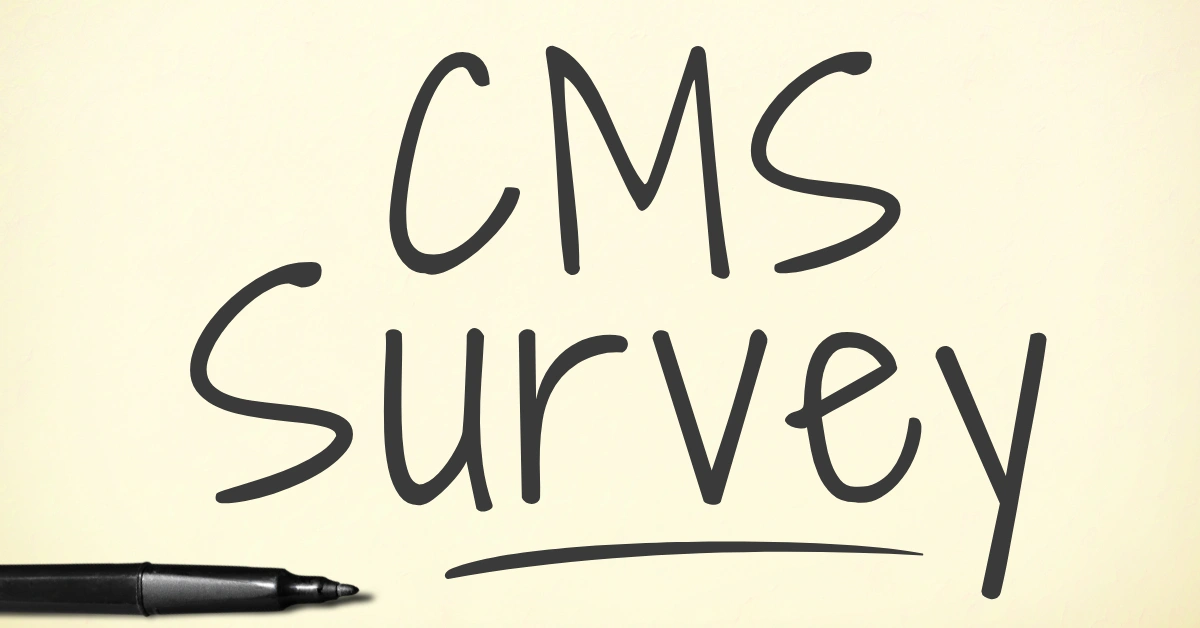Have you ever wondered how the survey team determines which residents they will focus on during a standard survey in the skilled nursing facility/long term care facility (SNF/LTC)? The answers submitted to the Center for Medicare and Medicaid (CMS) on the Minimum Data Set (MDS) are a starting point for the survey process.
MDS USAGE
The MDS is a versatile tool utilized as the beginning of individual resident care planning, contributing to a comprehensive facility assessment, driving Medicare and Medicaid reimbursement, and for monitoring of quality of care. Quality of care is reported for consumer access on the CMS website Care Compare, which incorporates both MDS data-driven quality measures and survey results. As stated in the Resident Assessment Instrument (RAI) Manual: “The data elements (also referred to as “items”) in the MDS standardize communication about resident problems and conditions within nursing homes, between nursing homes, and between nursing homes and outside agencies.”
After the MDS has been coded based on various sources such as resident interviews, the health record, and provider documentation, it is submitted to CMS. From there, the data elements are utilized to generate reimbursement, create individual facility quality measure reports, and create a pool of information for surveyor focus. The Long Term Care Survey Process (LTCSP) Procedure Guide offers insight into the prep work that goes into a standard survey. Prior to entering a facility, the survey team reviews offsite information about the residents in the facility, which is generated by MDS data. This information is collected through an MDS Indicator Facility Rate Report, along with any complaints and facility-reported incidents. Surveyors attempt to gather MDS data that is the most up to date as possible and use MDS indicators to proceed with in-person resident screening, resident interviews, and development of concerns. Although this is not the complete process for the development of the survey, the MDS does provide a starting point for identification of the final resident sample.
Once the surveyor has developed a final resident sample, the Critical Element Pathways, Regulations, and Interpretive Guidance in the State Operations Manual are utilized to complete the survey. The MDS is once again incorporated into the survey process through review of concerns for delay in completion and/or submission of MDS assessments, as well as MDS discrepancies.
Critical Element Pathways (CEP) can be found at Nursing Homes | CMS, located under Survey Resources and in the LTC Survey Pathways folder. CEPs are intended to guide surveyors in review of facility policies and procedures, observe staff provision of care, and conduct interviews of staff, residents, and families. CEPs can be a valuable tool for review of facility policies, processes, and practices as part of a Quality Assurance and Process Improvement (QAPI) plan in addition to a means of guiding facility’s prep for survey.
Survey Guidance
A review of the State Operations Manual (SOM) and interpretive guidance at § 483.20 provides information that guides facility staff and surveyors on CMS rules and regulations for MDS accuracy.
F636 Resident Assessment – “The facility must conduct initially and periodically a comprehensive, accurate, standardized reproducible assessment of each resident’s functional capacity.” (SOM page 232)
F637 Significant Change – “Within 14 days after the facility determines, or should have determined, that there has been a significant change in the resident’s physical or mental condition. (For purpose of this section, a “significant change” means a major decline or improvement in the resident’s status that will not normally resolve itself without further intervention by staff or by implementing standard disease-related clinical interventions, that has an impact on more than one area of the resident’s health status, and requires interdisciplinary review or revision of the care plan, or both.)” (SOM page 236)
F638 Quarterly Review Assessment – “A facility must assess a resident using the quarterly review instrument specified by the State and approved by CMS not less frequently than once every 3 months.” (SOM page 239)
F641 Accuracy of Assessments – Facilities are tasked with completing MDS that accurately reflects the resident’s status during the observation period of the MDS. This means that “the appropriate health professionals correctly document the resident’s medical, functional, and psychosocial problems and identify resident strengths to maintain or improve medical status, functional abilities, and psychosocial status using the appropriate Resident Assessment Instrument (RAI) (e.g. comprehensive, quarterly, significant change in status).” (SOP page 244)
Strategies
To ensure your data is accurate and reflective of the current resident’s status:
-
- Confirm your organization has an ongoing process of auditing MDS completion to verify accuracy, and integrate audit findings into the organization’s QAPI/QAA system.
- Review MDS updates that occur October 1st annually. Begin with competency-based training and continue training throughout the year. Audit the implemented changes and report audit findings to QAPI/QAA.
- Review and revise as needed policies and procedures related to the organization’s RAI system.
- Update data collection tools (in the electronic health record and/or on paper) to reflect October 1 changes to support collection of accurate and correct MDS data items.
- Designate alternate interdisciplinary team (IDT) members to complete interviews, complete data collection, and/or sign for completion, ensuring that crucial MDS items are not missed when the normal staff responsible takes time off.
- Utilize the Long Term Care Survey Process (LTCSP) Procedure Guide and the Critical Elements Pathways as tools for preparing for surveys, reviewing internal policies, and training staff.
MDS data is crucial in reporting quality measures, ensuring appropriate reimbursement, and facilitating the survey process. SNF and LTC providers that prioritize staff education about the RAI process and have policies in place that support timely and accurate data collection can ensure that the MDS requirements set forth in the SOM are met and the RAI rules are followed. Ultimately, facilities that have a great IDT process to ensure MDS accuracy create the best environment to support a successful standard survey.
More Resources
